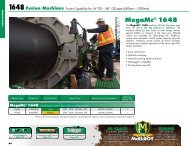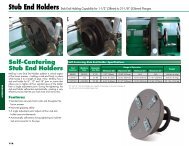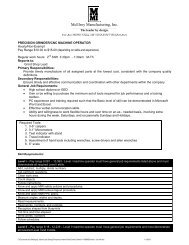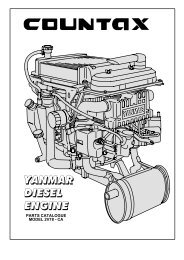THE TEN BILLION DOLLAR STANDARD ASTM D-2513 By: John ...
THE TEN BILLION DOLLAR STANDARD ASTM D-2513 By: John ...
THE TEN BILLION DOLLAR STANDARD ASTM D-2513 By: John ...
You also want an ePaper? Increase the reach of your titles
YUMPU automatically turns print PDFs into web optimized ePapers that Google loves.
<strong>THE</strong> <strong>TEN</strong> <strong>BILLION</strong> <strong>DOLLAR</strong> <strong>STANDARD</strong><strong>ASTM</strong> D-<strong>2513</strong><strong>By</strong>:<strong>John</strong> Goetz-Peoples EnergyDick Conley - Kerotest Manufacturing Corp.September 20091
ABSTRACT<strong>THE</strong> <strong>TEN</strong> <strong>BILLION</strong> <strong>DOLLAR</strong> <strong>STANDARD</strong>-<strong>ASTM</strong> D-<strong>2513</strong>Over the past forty years or more, the natural gas distribution industry in the U.S. hasmade a remarkable transformation from a near-exclusive metallic distribution pipingnetwork to a near-exclusive thermoplastic piping distribution network, primarily drivenby the development, implementation and constant upgrading of one standard, <strong>ASTM</strong>-D-<strong>2513</strong>, “Thermoplastic Gas Pressure Pipe, Tubing, and Fittings”. This transformation frommetal to plastic has saved US natural gas utilities in excess of $10 Billion in installationand maintenance costs over this period of time.PREFACEIn its simplest form, the natural gas industry is organized around two major functions-“Transmission” and “Distribution”.“Transmission” activities focus on the collection of natural gas from underground wellsor “Liquefied Natural Gas” (LNG) terminals, imported from abroad, and “transmission”via large diameter, high pressure pipelines throughout North America. The pressurewithin a transmission line is in the 1500 psi range. This is a very efficient means ortransmitting large volumes of gas from the point of discovery to the vicinity of the enduser. High strength steel pipelines are used for this activity and will continue to do so forthe foreseeable future.When “transmission pipelines reach populated areas, commonly referred to as city gates,the pressure is significantly reduced at regulator stations and the gas “distributed”throughout the community to the consumers or end-users of the gas. This articleaddresses the distribution side of the natural gas business.INTRODUCTIONThe natural gas distribution network in the United States is one of our largest, mostcomplex and vital infrastructures. From the very beginnings in the late 1700’s withBenjamin Franklyn’s gas lights to today’s sophisticated gas turbine generators, naturalgas is providing light, heat and power to millions of American homes and enterprises.This network of pipes, valves and fittings extends throughout every major city and townin America. Today it consists of over six (6) billion feet of gas distribution mains in theUnited States.Natural gas serves over 100 million homes, businesses, factories, churches, malls, arenasand other structures of every shape and size with clean, reliable and affordable energy.2
Natural gas is delivered safely and reliably to these various consumers via a network ofunderground pipe, valves and fittings. The earliest distribution pipes were made ofwhatever material was available including lead and wood. Some wood pipe was still inservice well into the 20 th century. As the distribution network grew, cast iron wascommonly used for mains and copper or steel used for individual services that took gasfrom the main into a home or business.Although cast iron, copper and steel are still in service, they present a number of majorissues that discouraged their continued use and expansion.1. For safety purposes, cast iron and ductile iron is normally limited to very lowpressures in the range of 5 psi or sometimes as low as inches of water columnpressure. However , there are a few gas distribution companies that operatesystems from 15 to 25 psi. This low pressure means a very large diameter pipe isrequired to provide an adequate volume of gas to the various consumers along thepath of the pipeline. In some cases, potential customers were not able to be servedsimply because the existing cast iron pipeline did not have adequate capacity.2. These large cast iron pipes are no longer than 16 feet in length; therefore, a jointand potential leak path exists every 16 feet within the network. Over time, due toground movement, external forces and corrosion, leakage at the joints has becomea major concern and most utilities now have multi-year programs underway toreplace all of their cast iron mains.3. Installation of cast iron and most steel pipe requires an open trench along theentire length of the pipeline. Excavation, installation and road repair areexpensive, time consuming and complex projects.4. Cast iron and steel works best when used in straight lines thus other utilities suchas electric, water and cable lines often must be moved to clear a path for the ironpipe.5. The disruption and/or closing of major streets and associated detours withinpopulated areas are both a major expense and public relations problem for theutilities.For all of these reasons and many more, natural gas utilities clearly recognized the needfor a better distribution pipeline material and to borrow a phrase from a popularcommentator, Paul Harvey, the following is “the rest of the story”.DISCUSSIONRecognizing the limitations of cast iron piping, most utilities began using steel pipes andcontinue to do so, especially for distribution systems with pressures above 125 psi up toabout 700 psi. Steel will continue to serve these applications although a plastic pipe hasrecently been approved for use up to 200 psi.Most gas distribution systems operate at 60 psi or less and at these lower pressures thestrength of steel cannot be fully exploited. Further, steel pipe is expensive, difficult toinstall and will corrode over time.3
The cost and performance limitations of cast iron and steel motivated the utilities to seekout alternative pipe material for their low pressure systems. Plastic pipe seemed like alogical choice. Plastic pipe was first installed in a natural gas distribution system in the1950’s. Various materials were tried including acetal, PVC and polypropylene butpolyethylene quickly became the material of choice because of its toughness, durability,low cost and ease of installation.In the 1950’s and ‘60’s, “plastic” was associated with cheap toys and a popular joke fromthe movie “The Graduate’. It was not considered a viable engineered product and thelong-term durability of plastic was unknown. It was with a very healthy dose ofskepticism that natural gas utilities began to evaluate plastic pipe, and in particular,polyethylene pipe for their gas distribution systems.It was recognized quite early in the 1960’s that no significant usage of polyethylene pipein natural gas service would occur without a valid industry-recognized standard for theproduct. <strong>ASTM</strong> and its consensus-driven standards development process was the answer.Engineers and others who belonged to <strong>ASTM</strong> D-20, Plastics, undertook the responsibilityfor developing the first consensus standard for plastic pipe specifically for natural gasservice. Their work resulted in the initial publication in 1966 of <strong>ASTM</strong> D-<strong>2513</strong> “StandardSpecification for Plastic Gas Pressure Pipe, Tubing and Fittings”.The work of improving D-<strong>2513</strong> and its companion standards eventually grew to the pointwhere it made sense to separate this activity from general plastic concerns and have aseparate committee dedicated to plastic pipe. In 1973, <strong>ASTM</strong> formed F-17 “PlasticPiping Systems” and D-<strong>2513</strong> and related standards were transferred to this newcommittee. Subcommittee F17.60 “‘Gas” was given the specific responsibility within F17for D-<strong>2513</strong> and it remains the responsibility of F17.60 to this date.Committee F17 currently has more than 400 dues-paying members and its main andsubcommittees are ‘in-balance”, meaning the User/General Interest members outnumberthe Producer member. It is well represented with utility users, government interests,consultants, producers and general interest personnel. A number of highly experiencedPhD’s are active as well as scientists and engineers from all the major disciplines. Morethan half of F17’s members have contributed ten (10) or more years of volunteer serviceto <strong>ASTM</strong> F17. Committee F17 members may be unique in their willingness to volunteerto lead Task Groups to initiate the standards writing or revision process; and, shareunselfishly their particular expertise for the mutual benefit of the entire industry.The wording of the Scope of D-<strong>2513</strong> has been revised several times over the past 43years but its focus has always been on plastic pipe, tubing and fittings for use with fuelgas mains and services in buried service. Today’s Scope reads, in part, “Thisspecification covers requirements and test methods for material, dimensions, tolerances,hydrostatic burst strength, chemical resistance and impact resistance of plastic pipe,tubing and fittings for use in fuel gas mains and services….The pipe and fittings coveredby this specification are intended for use in the distribution of natural gas..”.4
It is important to note that the Scope and focus of D-<strong>2513</strong> remains on products intendedfor the distribution of natural gas. Over the years, the acceptance and reputation of D-<strong>2513</strong> has grown to the point that many companies seek inclusion of their products in D-<strong>2513</strong> even though they are not intended for gas distribution service. The SubcommitteeF17.60 insists that all new products proposed for inclusion in D-<strong>2513</strong> satisfy its Scopeand the subcommittee resists all such non-gas inclusions and this has proven to be a wisedecision.As mentioned above, natural gas utilities were not ready to commit to plastic pipewithout a product standard such as D-<strong>2513</strong>; but, more importantly, they neededconfidence that products that satisfy D-<strong>2513</strong> also satisfy their needs. For over 40 yearsthe focus has been on satisfying gas industry needs.This focus on the gas industry is accomplished in several unique ways:1. The chairperson of F17.60 Gas has almost always been a gas utility engineer(User), not a Producer or General Interest member. He or she continues tomonitor all proposed additions or changes to the standard to insure it is bothapplicable to and a benefit to the industry. Many times a proposed project toupdate D-<strong>2513</strong> is accelerated because the resulting benefits are apparent to theUsers.2. The American Gas Association, Plastic Materials Committee (PMC) has technicalmembers participating from a significant number of utilities. They bring to theattention of the industry their concerns about the need for improving D-<strong>2513</strong>.They also recommend and monitor specific research and/or test programs toinsure the best possible products, processes and practices are employed by theindustry. Their concerns and recommendations are brought directly to F17.60 forinclusion into D-<strong>2513</strong>. This is an ongoing activity as shown by the fact that overthe years, D-<strong>2513</strong> has been revised, i.e., improved, 55 times. Not once has D-<strong>2513</strong>gone through the simple R & R (review and reissue) process because changes arealways forthcoming.3. The Plastic Pipe Institute (PPI) oversees the Hydrostatic Stress Board (HSB) thatdevelops and specifies the testing protocols required to obtain a HydrostaticDesign Basis (HDB) for a piping material. The materials’ HDB, in turn,determines the long-term pressure rating of the plastic material. The gas utilitiesuse the HDB of the material as the basis for designing the pressure capability oftheir distribution piping systems. PPI maintains a listing of the HDB values it hasapproved and all materials claiming compliance with D-<strong>2513</strong> must have a validHDB listing. To maintain a HDB listing with PPI, the material supplier mustretest his material on an ongoing basis.4. Organizations such as the Gas Research Institute, Southwest Research, BattelleInstitute, the University of Pennsylvania and others have done extensive researchon the behavior of plastic pipes and quantified the improvements achieved overthe years. One test in particular, called the PENT Test, measure the resistance ofthe material to slow crack growth, the most likely cause of pipe failure long-term.The higher the resistance, or longer time to failure during this test, the better thematerial for resistance to slow crack growth. Early materials developed in the 60’s5
and early ‘70s had a PENT test result of 1 hour or so. Today’s “highperformance” polyethylene pipe material must have a PENT value > 500 hoursand some exceed 2,000 hours or more. This 500 + hour PENT result equatestheoretically to an in-service life in excess of 100 years. Our great-grandkids willhave to tell us how well we’ve done.5. D-<strong>2513</strong> is not just a pipe standard but rather s piping system standard. Pipe aloneis worthless unless you can connect a source to one end and a customer to theother end and maintain control in between. Thus, D-<strong>2513</strong> not only addresses thespecific requirements for plastic pipe, but it also addresses the requirements for allvalves and fittings used in plastic natural gas piping systems. D-<strong>2513</strong> includesmandatory requirements for valves and various fittings by specific reference tothe appropriate product standards for these various items. When D-<strong>2513</strong> changesimpact another product standard, this standard is then updated as well to maintainthe overall harmony of all related standards. With control over all aspects of theplastic gas distribution system, weak links are eliminated and confidence in theperformance of the overall system is achieved.6. This standard D-<strong>2513</strong> is so highly regarded that it has become the law of the land.Natural gas safety is regulated by the U.S. Department of Transportation, Officeof Pipeline Safety. Regulations are written and contained in the United StatesCode of Federal Regulations, Part 192: “Transportation of Natural and Other Gas<strong>By</strong> Pipeline: Minimum Federal Safety Standards”. This regulation contains arequirement that states that all thermoplastic plastic pipe in natural gas service bein accordance with D-<strong>2513</strong>.7. State regulators such as the various state Public Utility Commissions rely on D-<strong>2513</strong> for guidance when overseeing and enforcing gas distribution system design,installation and maintenance.<strong>BILLION</strong> <strong>DOLLAR</strong> SAVINGSNow the really good stuff. As you can see, it is no accident that natural gas utilities havesuch faith in D-<strong>2513</strong>. They and a host of support experts have been working to improve itfor more than 40 years and 55 revisions to the standard are proof of the work done. Thisconfidence in plastic pipe produced to D-<strong>2513</strong> has led to its increased usage. Utilitieswisely started small with service line applications and mains through 2”, then 4” in size.Not too many years ago a manufacturer of polyethylene products through 4” size has a“complete” product line.As confidence grew, so did the plastic natural gas line sizes. Polyethylene pipe up thru12” ips is now very common and a fair amount of 18” and 20” polyethylene gas pipe hasbeen successfully installed.Today, polyethylene pipe represents:32 million feet of gas main (50.1% of all gas main in the U.S.)41 million individual gas services ( 63.4% of all gas services in the US)3 billion feet of pipe in service97% or more of all new distribution pipe today is polyethylene (PE).6
The two primary savings associated with the use of polyethylene pipe are:1. Installed Costs including the opportunity for alternative installation methods2. Reduced maintenance (corrosion) costsSince 1960 polyethylene pipe has evolved into the dominant material used in the gasdistribution industry and yearly over 32,000 miles of PE pipe are installed.INSTALLED COST SAVINGS:Average Cost per ft. to Install Gas Distribution Mains 1Pipe Size PE cost/ft.($)PE AverageCost/ft ($)Steel cost/ft.($)Steel AverageCost/ft. ($)2” ips 4.00 – 9.32 6.66 12.00 – 35.00 23.54” ips 8.00 – 15.56 11.78 16.00 – 32.00 24.006” ips 10.00 – 32.00 21.00 33.00 – 75.00 54.00Table 1From Table 1, the least difference in average installed cost is with the 4” size pipe wherethe average cost difference is (24.00 – 11.78) = $ 12.22 per foot.Average Material Cost Comparison2" 4" 6" 8" 12"Steel Main pf $3.09 $10.86 $22.19 $22.10 $29.00PE MAIN pf $0.64 $2.06 $4.53 $7.71 $14.73Difference pf 79.44% 81.02% 79.60% 65.09% 49.19%Table 2Material savings alone range from $2.45/ft for 2” diameter pipe to $17.66/ft for 6”diameter pipe. This is almost a 80% savings in material alone.If all 3 billion feet of polyethylene pipe currently installed enjoyed that same savingsdifference, the total savings would be in the range of $36 billion.It’s true that much of the installed PE pipe is smaller than 4” and the 1” and under sizepipe may not enjoy the exact same savings. However, even if we discount the overallsavings by 50%, we are still saving $18 billion; and we’re just getting started!1 Tubbs, 43 rd Annual Pipe Report – “Gas Demand, Maintenance Projected to Drive Distribution Spending”,Pipeline Gas Journal, December 20087
MAIN<strong>TEN</strong>ANCE (CORROSION PREVENTION) COST SAVINGSInstallation of steel pipe brings with it the requirements of Part 192 , Transportation ofNatural Gas and Other Gas by Pipeline , Minimum Federal Safety Standards . Beginning1971 all underground steel pipe installed must be cathodically protected, monitored,and records kept. These are not trivial requirements.Annual Operating and Maintenance costs associated with steel piping for the U.S. isestimated to be $2.2 billion. This is the annual cost of maintaining 475,000 miles ofcorrosion protected steel main and 15.3 million corrosion protected services. These costsultimately get passed on to the consumer in the price they pay for natural gas. If not forthe use of polyethylene pipe to D-<strong>2513</strong>, this maintenance cost would be over $4 billion,each year. As one can see, preventive maintenance costs associated with steel pipe is veryexpensive.With polyethylene pipe these maintenance and monitoring costs go away, saving literallybillions of dollars per year and contributing to more value for the consumer.O<strong>THE</strong>R BENEFITSIn addition to the obvious dollars saved with the use of plastic pipe, there are at least twosignificant non-quantitative benefits resulting from the usage of plastic pipe:1. Reduced carbon footprint2. Emergency ResponseCARBON FOOTPRINTAn additional and increasingly more important benefit of polyethylene pipe is the smallercarbon footprint it produces. Technology related to trenchless excavation (insertion thruexisting mains), directional drilling, use of coiled piping, and other insertion techniquesall contribute. Significantly less trucking, less time-consuming detours, less disposal ofexcavated materials, and less paving restoration is realized with the use of polyethylenepipe made to D-<strong>2513</strong>.EMERGENCY RESPONSEThe ability to act quickly in an emergency situation is priceless. Protecting life andproperty are fundamental in the operation of a gas distribution infrastructure.Polyethylene allows for quicker shutoff with its squeeze off capabilities. Repairs canusually be made quicker, allowing for more timely restoration of service and greatercustomer satisfaction. Savings – Priceless !8
CONCLUSIONThe title and headline of this report refers to D-<strong>2513</strong> as a $10 billion dollar standard but itmay be more accurate to say “tens of billion” dollar standard. It has had that much of animpact on the installation and maintenance practices of the natural gas distributionindustry in the United States. <strong>ASTM</strong> D<strong>2513</strong> is a standard to be proud of. It touches manyand contributes to a higher quality of life .As Walter Cronkite closed his News casts – “and that’s the way it is”.9
















